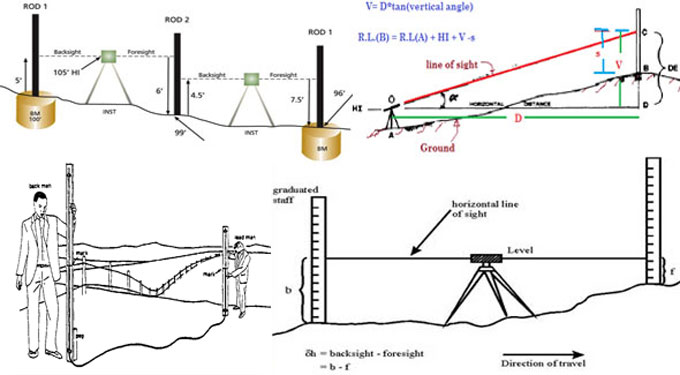Some important terminologies in surveying and leveling
Leveling stands for the method of finding out the relative elevations of several objects or points on the earth's surface. It is performed by picking up measurements in the vertical plane. A leveling instrument known as ?Level? and ?Staff? is appointed for this purpose along with other equipments.
Given below, some vital terms in Surveying and Leveling :-
Level Surface: It refers to a surface that is normal to the direction of gravity at all points as stated by a plumb line. As for instance, the surface of a still lake can be a level surface.
Since the earth is an oblique spheroid, a level surface should not belong to a plane but should be a cursed one. The distance of each point on a level surface is equal from the center of the earth.
Level Line: A level line belongs to a line that is laid on a level surface. It is normal to the plumb line at all points.
Horizontal Plane: A horizontal plane through a point refers to a plane peripheral to the level surface at the point. It is normal to the direction of gravity at that point.
Horizontal Line: A line that remains at a 90 degree angle to the plumb line and tangent to a level surface is called a horizontal line.
Vertical Plane: A vertical plane belongs to any plane with a vertical line. A vertical line at any point stands for a line normal to the level surface at that point.
A plumb line is an instance of a vertical line.
Datum Surface: A datum or datum surface is the level of a point or the surface relating to which levels of other points or planes are measured.
Elevation of a Point: Elevation of a point is the vertical distance above or below the datum. This is usually called the reduced level (R.L) of the point. This may be positive or negative accordingly as the point is above or below the datum.
Line of Collimation: The line of collimation or the line of sight stands for the line that connects the junction of cross-hairs to the optical center of the object glass and its continuation.
Axis of Telescope: The axis of a telescope stands for the line that connects the optical center of the object glass to the center of the eye piece.
Axis of Bubble Tube: The axis of bubble tube or level tube refers to the line tangential to the longitudinal curve of bubble tube at its centre point. It remains horizontal when the bubble is centered. It is also known as ?bubble line.?
Vertical Axis: The vertical axis stands for the line about which the telescope is revolved in a horizontal plane.
Mean Sea Level (MSL): MSL refers to the average height of the sea for all phases of the tides. At any specific place MSL is set by determining the mean sea level (free of tides) after averaging tide heights over a long period of minimum 19 years.
Reduced Levels (RL): The level of a point captured as height over the datum surface is called as RL of that point.
Benchmarks: A benchmark refers to a relatively permanent reference point, the elevation of which is defined as w.r.t. MSL. It is utilized as a starting point for leveling or as a point upon which to close for a check.



